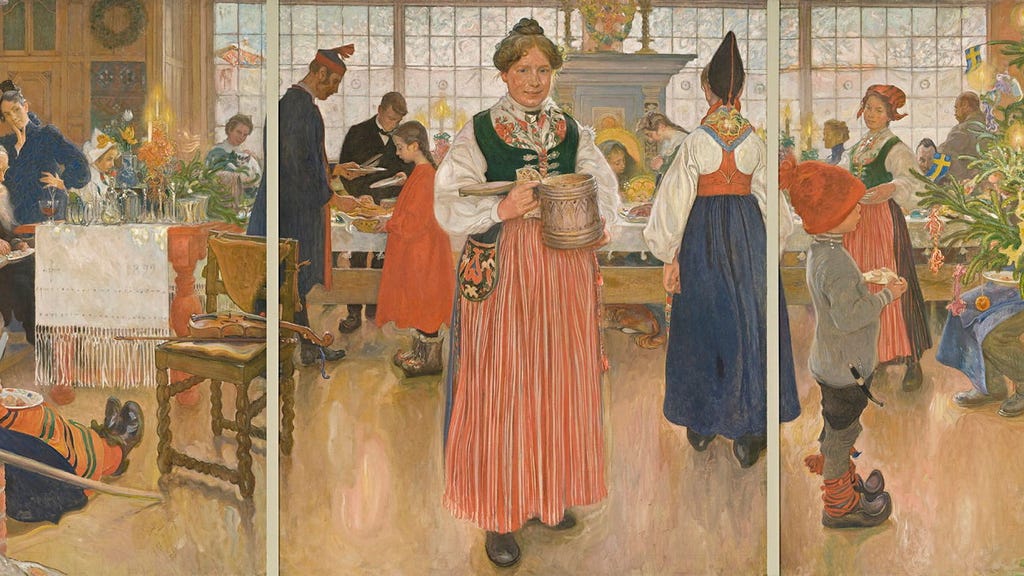Carl Larsson’s iconic triptych, ”Nu är det jul igen” (Now it’s Christmas again), captures a seemingly idyllic Christmas morning at the artist’s home, Lilla Hyttnäs, in Sundborn, Sweden, in 1906. This monumental work, owned by Helsingborgs museer, is traditionally displayed at Dunkers kulturhus during the Christmas season, offering viewers a glimpse into a bygone era of festive celebration. The painting portrays the family’s Christmas breakfast, a scene brimming with warmth, togetherness, and abundant traditional fare. The meticulously detailed artwork depicts not only the Larsson family but also members of the household staff, all dressed in vibrant Sundborn attire, suggesting a harmonious and inclusive celebration. This image resonates with a sense of nostalgia, presenting an idealized vision of Christmas, a comforting retreat from the potential stresses and chaos of modern celebrations.
The painting’s charm lies in its depiction of a seemingly perfect Christmas morning. The table is laden with a feast fit for the season – ”sylta” (head cheese), ”pressylta” (pressed head cheese), smoked mutton, meatballs, and the centerpiece, the ”holy Christmas ham.” Larsson’s attention to detail extends beyond the culinary delights to include the festive decorations adorning the room, creating a warm and inviting atmosphere. Even the beverages, home-brewed beer and aquavit served in delicate glasses, contribute to the sense of celebratory abundance. The inclusion of household staff in the scene, participating in the festivities alongside the family, further reinforces the impression of a communal celebration transcending social hierarchies.
Beyond the surface depiction of a joyful Christmas gathering, Larsson subtly incorporates religious symbolism into the composition. Behind the prominent Christmas ham, he has placed figures of the Virgin Mary and the infant Jesus, with his daughter Lisbeth seemingly in adoration. This subtle integration of religious imagery within the domestic scene underscores the spiritual significance of Christmas within the Larsson family and the broader cultural context of the time. The painting, therefore, becomes more than just a portrayal of a family gathering; it embodies the spirit of Christmas itself, blending the secular celebration with its underlying religious meaning.
The enduring appeal of ”Nu är det jul igen” lies in its ability to evoke a sense of nostalgia and longing for a simpler, more harmonious past. It presents a romanticized image of Christmas, free from the commercial pressures and anxieties that often accompany modern celebrations. For many, the painting serves as a visual reminder of the core values of Christmas – family, togetherness, and the sharing of traditions. This idealized representation offers a comforting escape from the complexities of contemporary life, allowing viewers to immerse themselves in a world of warmth, abundance, and shared joy.
The decision by Dunkers kulturhus to annually display the painting during the Christmas season is a testament to its enduring cultural significance. The artwork resonates with audiences across generations, inviting them to connect with the spirit of Christmas through Larsson’s evocative portrayal. It serves as a focal point for shared memories and traditions, reinforcing the importance of community and togetherness during the festive period. The painting’s prominent placement within the museum during Christmastime transforms the space into a place of reflection and celebration, offering visitors an opportunity to pause and appreciate the enduring magic of Christmas.
In a world often characterized by rapid change and increasing complexity, ”Nu är det jul igen” provides a timeless anchor to the enduring values of Christmas. It offers a visual respite from the demands of modern life, transporting viewers to a world of warmth, harmony, and shared celebration. The painting’s enduring popularity underscores the human need for connection, tradition, and a sense of belonging, particularly during the festive season. Larsson’s masterpiece continues to captivate and inspire, reminding us of the simple joys and profound meaning that lie at the heart of Christmas.














